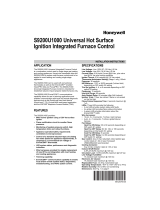
PN# 500-16000
Page 5 Rev. C, 04/11
In the other modes, you use a trigger input from an N.O. or N.C. switch. Since the on delay
mode is self triggering and begins when the timer is powered, it appears that only a normally
open switch can be used. There is a way around this however if you have only a normally closed
signal available. The "R" terminal is employed. The timer should be powered continuously with
the normally closed external switch connected between "+" and R. With the board in continuous
reset, it will not start timing. When the switch opens, it will be as if the board was just powered
and it will go through its on delay cycle until the switch closes again putting the board into reset.
6.2 TRIGGERED ON DELAY
Triggered on delay differs from standard on delay in that a momentary trigger latches in the on
delay function. To set up triggered on delay, Dip switches 3 and 4 are turned on and Dip
Switch 2 is turned off. Then, an N.O. switch is connected between "T" and "+". The board
should be continuously powered and when the trigger first closes , the delay period will begin.
Successive operations of the trigger will have no effect. When the unit times out, the relay will
energize and will stay energized until a second momentary switch closes between the reset
terminal ("R") and "+". Triggered on delay can only be initiated and reset from normally open
switches.
6.3 OFF DELAY
Off delay functions as follows: The timer is continuously powered and an external switch is
closed to trigger the function. This is done by connecting the "+" terminal to the T (trigger)
terminal. Once the trigger is closed to the + terminal, the relay energizes. If the trigger is left
closed, the relay will stay energized indefinitely. Once the trigger is opened, the delay begins.
The relay stays energized until time out and then it deenergizes ready for the next operation.
The term "off delay" is derived from the fact that timing begins when the trigger is opened
(turned off).
If the trigger is closed and opened again during the delay, the relay will stay energized but the
time set will begin again. This aspect of the off delay function is called retriggerability. The
delay can be extended any number of times by retriggering without the relay deenergizing.
6.4 ONE SHOT
One shot can be considered non-retriggerable off delay. The timer is continuously powered and
an external switch is closed to trigger the function. This is done by connecting the "+" terminal
to the T (trigger) terminal. Once the trigger is closed to the + terminal, the relay energizes and
deenergizes after time out regardless of the state of the trigger switch. The trigger switch can
remain closed or can be switched during the timing cycle without affecting the fact that the relay
will deenergize after time out. The switch must then go from open to closed to start a new
cycle.
6.5 PULSE OUTPUT
If the time is set for zero (all 8 time setting switches off) when in the off delay mode, the unit
becomes a one shot pulse generator. When the trigger is closed, the relay immediately
energizes and deenergizes 1/5 second later even if the trigger remains closed for an indefinite
time longer than the pulse. When the trigger opens and closes again another pulse is
generated.
6.6 TOGGLE MODE
The toggle mode functions as follows: When the trigger is closed, the relay energizes and stays
energized. When the trigger is closed a second time, the relay deenergizes and stays
deenergized. The toggle mode creates a ratcheting relay and allows conversion of a momentary
input to an alternate output. The time setting in the toggle mode is not functional.








